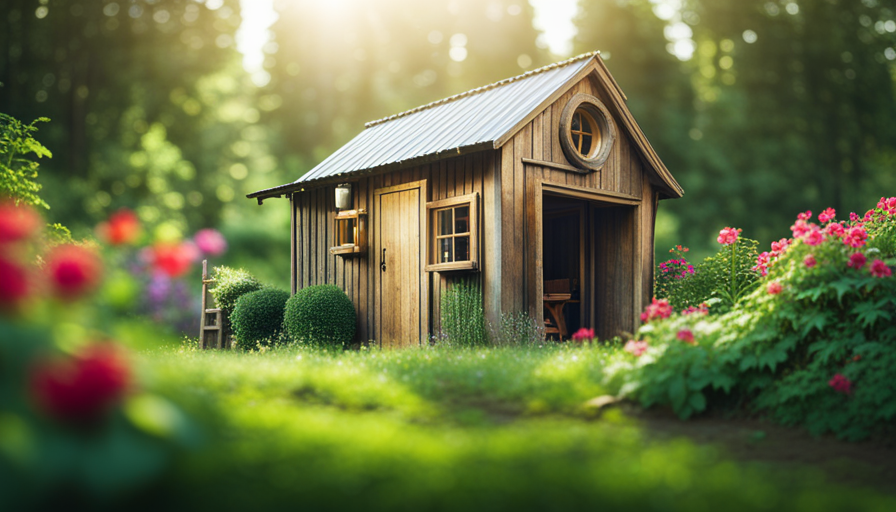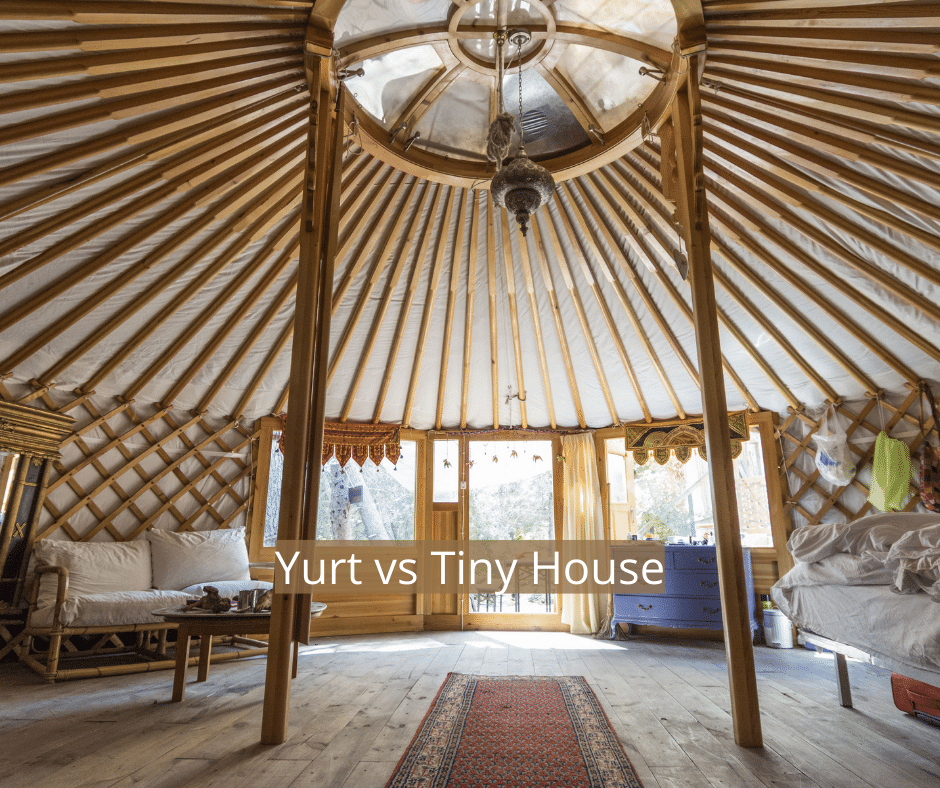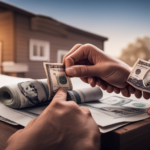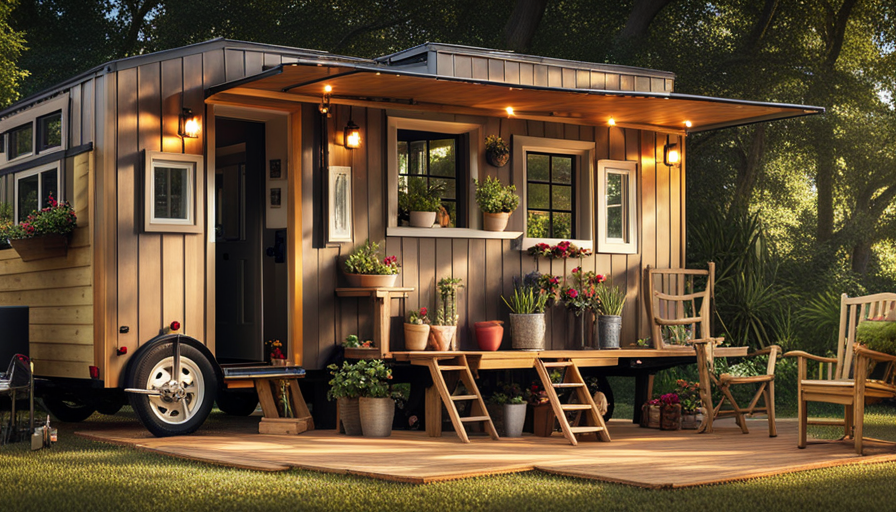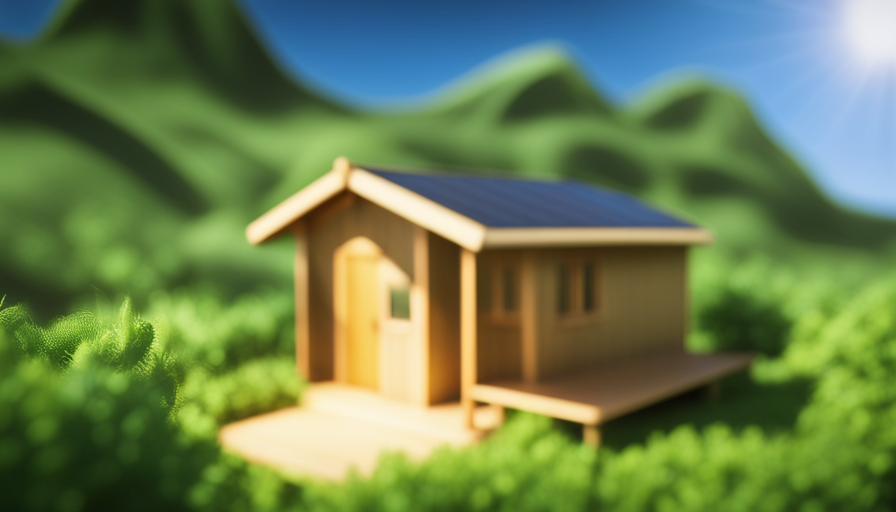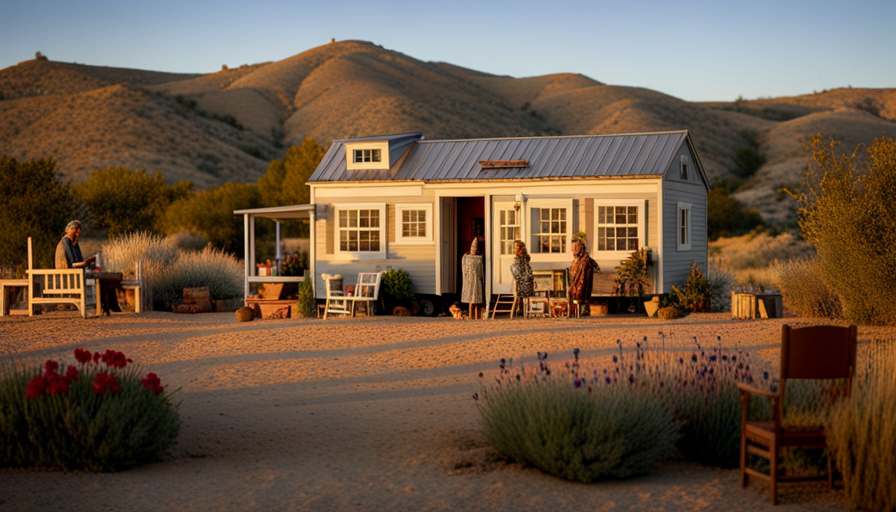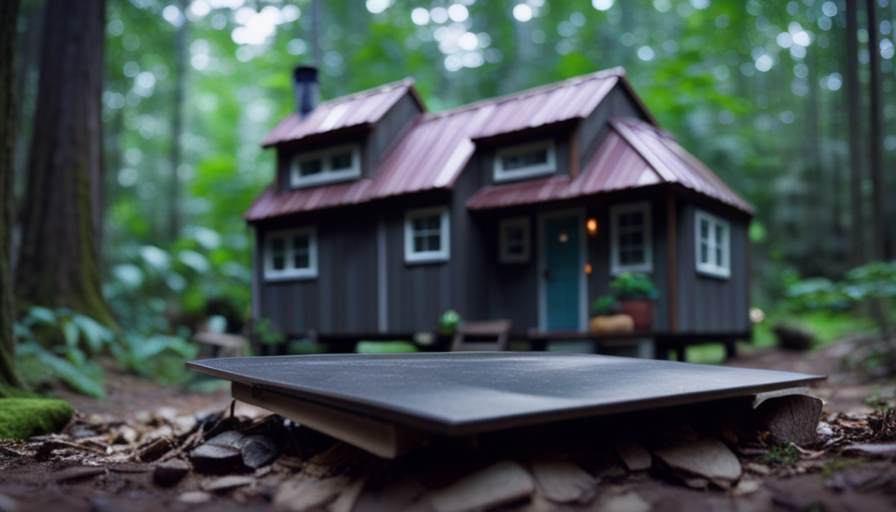Oh, the joy of having a home! It’s a goal we dream of, work hard for, and save diligently to accomplish. But what if I told you there’s a way to own your dream house in much less time? Yes, my friend, I’m talking about the world of tiny houses.
These pint-sized dwellings are all the rage these days, offering a minimalist lifestyle and the freedom to live debt-free. But before you dive headfirst into the tiny house movement, let’s take a step back and analyze just how long it will take to pay off one of these little wonders.
In this article, we’ll explore budgeting options, financing strategies, and even alternative routes like RV loans or personal loans. So buckle up and get ready to embark on a journey towards financial freedom with your very own tiny house.
Key Takeaways
- Tiny houses offer a minimalist lifestyle and freedom from debt.
- Financing options for tiny houses include traditional mortgages, personal loans, in-house financing, and rent-to-own programs.
- Loan terms affect the overall cost and repayment time, with different terms resulting in varying monthly payments and total interest paid.
- Budgeting strategies and prioritizing payments based on interest rates and terms can accelerate the payoff of a tiny house.
Determine Your Budget and Financing Options
Before you can start daydreaming about your cozy tiny house, it’s important to figure out how much you can afford and explore different ways to finance it.
Financing options for tiny houses can vary, so it’s crucial to do your research and find the best fit for your situation. One option is to apply for a traditional mortgage, although this can be challenging for tiny houses due to their unconventional nature. Another financing option is a personal loan, which can provide the funds you need with more flexibility. Additionally, some tiny house builders offer in-house financing or rent-to-own programs, allowing you to make monthly payments directly to them.
Determining the ideal budget for a tiny house involves considering not only the cost of the house itself but also any additional expenses such as land, utilities, and permits. It’s important to be realistic about what you can afford and to factor in any potential maintenance costs. Creating a detailed budget will help you stay on track and ensure that you’re not taking on more debt than you can handle.
Once you’ve explored financing options and determined your budget, it’s time to research and compare tiny house prices. This will give you a better understanding of the market and help you make an informed decision about which tiny house is right for you.
Research and Compare Tiny House Prices
When looking at the cost of different tiny houses, it’s helpful to research and compare their prices. Here are three research methods to consider when comparing tiny house prices:
-
Online Listings: Start by searching online platforms that specialize in tiny house listings. Websites like Tiny House Listings and Tiny House Marketplace offer a wide range of options, allowing you to compare prices and designs from various sellers. These platforms often provide detailed descriptions, photos, and contact information to help you gather all the necessary information.
-
Visit Tiny House Builders: Another effective research method is to visit tiny house builders in person. This allows you to see the quality of construction, materials used, and speak directly with the builders. You can ask questions, discuss customization options, and get a better sense of the overall value for the price.
-
Attend Tiny House Expos: Tiny house expos are great opportunities to see a wide variety of tiny house designs and builders in one place. These events usually have multiple vendors showcasing their products, allowing you to compare prices, features, and styles side by side. It’s a great way to get inspiration, gather ideas, and get a sense of the average price range for different types of tiny houses.
By researching and comparing tiny house prices using these methods, you can make an informed decision about which tiny house suits your budget and needs. Considering the length of your loan term is the next step in determining how long it will take to pay off your tiny house.
Consider the Length of Your Loan Term
One important factor to consider is the duration of your loan agreement when determining the timeframe for repaying your compact dwelling. The length of your loan term can greatly impact the overall cost of your tiny house and how long it will take you to pay it off.
When choosing a loan term, it’s essential to consider your financial situation and goals. A shorter loan term may result in higher monthly payments but can save you money in the long run by reducing the amount of interest you pay. On the other hand, a longer loan term may offer lower monthly payments but could result in paying more interest over time.
To illustrate the impact of different loan terms, let’s take a look at the following table:
| Loan Term | Monthly Payment | Total Interest |
|---|---|---|
| 10 years | $XXX | $XXX |
| 15 years | $XXX | $XXX |
| 20 years | $XXX | $XXX |
| 30 years | $XXX | $XXX |
As you can see, the length of your loan term can significantly affect your monthly payments and the total amount of interest paid. It’s important to carefully consider these loan term considerations and the impact of interest rates when deciding on the best option for your tiny house financing.
In the next section, we will explore how to calculate monthly payments and interest rates for your tiny house loan.
Calculate Monthly Payments and Interest Rates
Now let’s dive into calculating your monthly payments and interest rates for your adorable abode.
When it comes to determining the financial feasibility of your tiny house, it’s crucial to calculate the interest rates and monthly payments accurately. The interest rate is the percentage charged by the lender for borrowing the money, and it plays a significant role in the overall cost of your loan.
To calculate the interest rates, you’ll need to consider your credit score, the loan amount, and the loan term. A higher credit score generally translates to a lower interest rate, while a longer loan term may result in a higher interest rate.
Once you have the interest rate, you can determine your monthly payments using a loan calculator or by manually calculating the amount based on the loan term and interest rate.
By understanding the financial implications of your loan, you can make informed decisions about your tiny house purchase. As we explore budgeting strategies to accelerate payment, it’s essential to keep these calculations in mind to ensure you stay on track towards owning your dream tiny house.
Explore Budgeting Strategies to Accelerate Payment
Let’s uncover some creative ways to speed up your payment and make owning your dream tiny house a reality even sooner! When it comes to paying off your tiny house, there are several budgeting strategies that can help you accelerate the payoff process. Here are a few ideas to consider:
-
Cut back on unnecessary expenses: Take a closer look at your monthly budget and identify areas where you can trim down your spending. By cutting back on non-essential items, you can free up more money to put towards your tiny house payments.
-
Increase your income: Explore opportunities to boost your income, such as taking on a side gig or freelancing. Any additional money you earn can be directly applied to paying off your tiny house faster.
-
Make extra payments: Whenever you have some extra money, whether it’s a tax refund or a bonus, consider making an extra payment towards your tiny house. Even small additional payments can make a significant impact on reducing your overall payment term.
By implementing these budgeting strategies, you can accelerate your payoff and bring yourself closer to owning your dream tiny house. Once you have a better idea of how long it will take you to pay off your tiny house, you can then factor in additional expenses such as utilities and maintenance.
Factor in Additional Expenses such as Utilities and Maintenance
Consider incorporating the costs of utilities and maintenance into your overall financial plan to ensure a comprehensive understanding of the expenses associated with owning and maintaining your dream tiny house.
When budgeting for a tiny house, it’s important to factor in the additional expenses that come with it. Utilities expenses, such as electricity, water, and gas, can vary depending on the size and location of your tiny house. You’ll need to research and estimate these costs to accurately plan your budget.
Maintenance costs are another aspect to consider. While tiny houses may require less maintenance compared to traditional homes, they still require regular upkeep. This includes tasks such as painting, roofing repairs, and general cleaning. It’s essential to account for these costs in your financial plan to avoid any unexpected expenses.
By factoring in utilities and maintenance costs, you’ll have a more realistic idea of the financial commitment of owning a tiny house. This will help you better prepare for any unexpected expenses that may arise.
Additionally, considering the benefits of downsizing and cost savings can further enhance your financial plan.
Transitioning into the subsequent section, it’s important to explore the advantages of downsizing and how it can contribute to paying off your tiny house sooner.
Consider the Benefits of Downsizing and Cost Savings
Experience the freedom and financial relief of downsizing your living space, while enjoying the cost savings that come along with it. There are numerous benefits to downsizing to a tiny house, both in terms of your lifestyle and your wallet.
One of the main advantages is the significant reduction in expenses. With a smaller space, you’ll find that your utility bills, such as electricity and water, are much lower. Heating and cooling costs are also reduced as you need less energy to maintain a comfortable temperature. Additionally, the maintenance costs for a tiny house are typically lower compared to a traditional home. With fewer rooms and less square footage, you’ll spend less time and money on repairs and upkeep. These financial advantages of downsizing can help you pay off your tiny house more quickly and achieve financial independence sooner.
Furthermore, downsizing opens up opportunities for alternative financing options. With the lower cost of a tiny house, you may be able to explore alternatives such as RV loans or personal loans, which often have more favorable terms than traditional mortgages. These options can provide you with the flexibility and freedom to choose the best financing route for your specific situation.
So, experience the benefits of downsizing and the financial advantages it brings, and then explore alternative financing options such as RV loans or personal loans to make your tiny house dream a reality.
Explore Alternative Financing Options such as RV loans or personal loans
Exploring alternative financing options, such as RV loans or personal loans, can provide the flexibility and freedom needed to turn your tiny house dream into a reality.
When it comes to financing a tiny house, RV loans can be a viable option. Many tiny houses are built on wheels, making them eligible for RV financing. This type of loan often offers competitive interest rates and longer repayment terms compared to traditional personal loans.
RV financing has its pros and cons. On the positive side, it allows you to secure a loan specifically designed for recreational vehicles, and the interest may be tax-deductible if the tiny house meets certain criteria. However, there are some drawbacks to be aware of. RV loans typically require a down payment and may have stricter lending criteria. Additionally, since tiny houses are still a relatively new concept, not all lenders may be familiar with financing them.
Another alternative financing option is a personal loan. Personal loans can be used for various purposes, including financing a tiny house. They generally have shorter repayment terms and higher interest rates compared to RV loans. However, personal loans offer more flexibility in terms of usage and may not require a down payment.
To make an informed decision, it’s crucial to seek professional advice from financial advisors or mortgage brokers who specialize in tiny house financing. They can guide you through the process, explaining the best options available based on your financial situation and goals.
Transitioning into the subsequent section, seeking professional advice will help you navigate the complexities of financing a tiny house.
Seek Professional Advice from Financial Advisors or Mortgage Brokers
If you really think you know everything about financing, then by all means, skip seeking professional advice from financial advisors or mortgage brokers. But if you want to make the best decisions for your tiny house financing, it’s worth considering the benefits of consulting with a financial advisor.
These professionals have a deep understanding of the financial landscape and can provide valuable insights tailored to your specific situation. They can help you navigate the complexities of financing options, analyze the costs and benefits, and guide you towards the most suitable choice. By working with a financial advisor, you can gain a clearer understanding of the long-term implications of your financing decisions and ensure that you’re making a sound investment.
On the other hand, mortgage brokers can also offer cost savings when it comes to financing your tiny house. These experts have access to a wide range of lenders and can help you find the best mortgage rates and terms. They can negotiate on your behalf and save you time and effort in the application process. By leveraging their expertise and industry connections, mortgage brokers can help you secure a loan that aligns with your financial goals and requirements, potentially saving you money in the long run.
By seeking professional advice from financial advisors or mortgage brokers, you can make informed decisions about your tiny house financing. These experts can provide valuable insights and cost-saving opportunities. With their guidance, you can set realistic goals and create a payment plan that works for you.
Set Realistic Goals and Create a Payment Plan
Creating a realistic payment plan is like mapping out a journey, ensuring that each step is carefully planned and leads you closer to your financial goals. When it comes to paying off a tiny house, setting achievable goals and creating a realistic timeline is key. Here are some important considerations to keep in mind:
-
Understand your financial situation: Take a close look at your income, expenses, and any other financial obligations you may have. This will help you determine how much you can realistically allocate towards paying off your tiny house each month.
-
Prioritize your payments: Make a list of your debts and prioritize them based on interest rates and terms. By paying off higher interest debts first, you can save money in the long run.
-
Explore different payment options: Consider different payment strategies, such as making bi-weekly payments or increasing your monthly payments when possible. This can help you pay off your tiny house faster and save on interest.
-
Stay disciplined: Stick to your payment plan and avoid unnecessary expenses or taking on additional debt. It’s important to stay focused and committed to reaching your goal.
-
Regularly reassess your plan: As your financial situation changes, it’s important to reassess your payment plan and make any necessary adjustments. This will help you stay on track and ensure that your goals remain achievable.
By setting achievable goals and creating a realistic timeline, you can effectively pay off your tiny house and achieve financial freedom.
Frequently Asked Questions
Can I get a mortgage for a tiny house?
Sure, you can get a mortgage for a tiny house. There are various mortgage options available for financing alternatives. While traditional mortgages may not be suitable for tiny houses, there are specialized lenders who offer loans specifically for these types of homes.
These lenders understand the unique nature of tiny houses and can provide flexible financing options that cater to your needs. So, you have options when it comes to financing your dream tiny house.
How much does it cost to build a tiny house?
The cost to build a tiny house can vary depending on several factors. A cost breakdown typically includes expenses for materials, labor, and permits. Financing options for building a tiny house can include personal savings, loans, or crowdfunding. It’s important to research and compare different financing options to find the best fit for your situation.
By considering these factors, you can determine the overall cost of building a tiny house and explore financing options that align with your budget.
Are there any grants or financial assistance programs available for tiny house buyers?
Oh, the joys of buying a tiny house! You’d think that with all the hype surrounding them, there would be an abundance of grants and financial assistance options for us tiny house enthusiasts. Unfortunately, that’s not quite the case.
While there are some organizations that offer grants for tiny house buyers, they are few and far between. As for financial assistance, it’s a bit of a mixed bag. Some banks and credit unions may be willing to work with you, but it’s definitely not as straightforward as getting a traditional mortgage.
Is it possible to get a loan with bad credit to buy a tiny house?
Yes, it’s possible to get a loan with bad credit to buy a tiny house. While traditional lenders may be hesitant to offer loans to individuals with bad credit, there are alternative financing options available. These may include lenders who specialize in bad credit loans or peer-to-peer lending platforms.
It’s important to do thorough research and compare different options to find the best terms and interest rates that suit your financial situation.
What are the potential tax implications of owning a tiny house?
As a tiny house owner, there are potential tax benefits and legal considerations to be aware of.
Regarding tax implications, some states may offer property tax exemptions or reduced rates for tiny houses. Additionally, if your tiny house is considered a second home, you may be eligible for mortgage interest deductions.
However, it’s important to consult with a tax professional to understand the specific regulations and requirements in your area.
Conclusion
In conclusion, paying off a tiny house requires careful planning and consideration of various factors. By determining your budget, researching prices, and exploring financing options, you can create a realistic payment plan.
Additionally, utilizing budgeting strategies and downsizing can help accelerate the payment process. It’s important to seek professional advice and explore alternative financing options to find the best solution for your situation.
Remember, Rome wasn’t built in a day, so take your time and stay focused on your goal.
Hi, I’m Emma. I’m the Editor in Chief of Tiny House 43, a blog all about tiny houses. While tree houses are often associated with childhood, they can be the perfect adult retreat. They offer a cozy space to relax and unwind, surrounded by nature. And since they’re typically built on stilts or raised platforms, they offer stunning views that traditional homes simply can’t match. If you’re looking for a unique and romantic getaway, a tree house tiny house might just be the perfect option.
